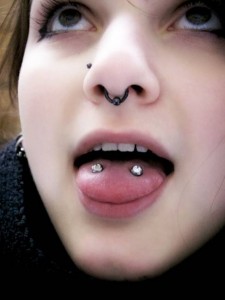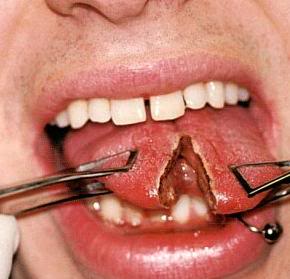Tongue Piercing – Pictures, AfterCare, Risks, Price, Horizontal
What is Tongue Piercing?
Tongue Piercing, also known as oral piercing, is a component of body piercing which is done through the center of a person’s tongue. It involves piercing the tongue and inserting a foreign object until the wound heals. This will eventually lead to a tunnel formation around the foreign object, creating a suitable place for wearing a variety of jewelry.

Tongue piercing is also considered as an art form by some people. Others would consider tongue piercing as a cultural necessity, gratification of the sexual desires, psychological comfort after traumatic physical experience, or fashion statement. Historically, soldiers of the Roman period underwent tongue piercing to show their courage before they engaged in war. People who practiced tongue piercing as part of ritual practices belonged to the tribes of Haidas, Aztecs, Kwakiutls, Mayas of Central America, and Tlingit Indians of Northwest America.
Types of Tongue Piercings
There are many types of tongue piercing from which to choose. The following are the various types of tongue piercing:
Horizontal tongue piercing
Horizontal tongue piercing is a type of tongue piercing where the piercing is done horizontally through the tongue.
Tongue surface piercing
Tongue surface piercing is another type of piercing where the piercing material is placed anywhere on the tongue surface. It can be done through the top, tip, or bottom of the tongue, and perpendicular and lengthwise placements are possible. Tongue surface piercing can be classified either as scoop or lingum piercing.
Vertical tongue piercing
Vertical tongue piercing is another type of tongue piercing where the piercing material or jewelry is placed vertically.
Frenulum linguae piercing
This is a type of tongue piercing where the piercing is done through the frenulum located underneath the tongue.
Tongue web piercing
Tongue web piercing is a type of tongue piercing where the piercing jewelry goes through the underside webbing of the tongue. Compared to other tongue piercing types, tongue web piercing heals quickly, and the jewelry most often used is either a straight, curved barbell or captive bead ring.
Tongue rim piercing
Another variation of tongue surface piercing is tongue rim piercing. The jewelry that is used here is either a captive ring or a bead ring.
Mid-line tongue piercing
Mid-line tongue piercing is done along the mid-line of the tongue. It is the most traditional and common placement for a tongue piercing.
T-Bar piercing
Last but not the least, T-bar piercing, the most complicated form of tongue piercing, involves three or more exit holes and one single jewelry piece.
Do Tongue Piercings Hurt?
This is mostly the significant question that comes to mind, especially for people who never experienced tongue piercing before. According to those who have tried tongue piercing, the piercing if done professionally, will be like biting the tongue. However, the level of pain will differ from one person to another. Piercer, tolerance level, state of mind, and overall mood will greatly affect the tongue piercing experience.
How Much are Tongue Piercings?
The type of tongue piercing and the place where it is performed will determine the actual cost of the tongue piercing. According to experts who work in the tongue piercing industry, the actual tongue piercing will cost around $20 to $50 at most. It is better to check the exact price at the piercing shop.
Do Tongue Piercings Close Up?
The answer to another interesting question is yes, it does close up. Anatomically speaking, the tongue is one of the regions where there is a blood flow increase which allows the pierced tongue area to close up. The time it will close up will vary from one person to another. When the tongue ring is removed, the pierced area will close up. The time it takes to close up the pierced site is approximately about a maximum of 6 weeks.
Tongue Piercing Gone Wrong? What to Do?
Panic will not help you. Experts advise to consult a knowledgeable medical expert or a licensed tongue piercer when tongue piercing goes wrong. Most importantly, the licensed tongue piercer should have all the necessary equipment to perform the piercing, especially when it does go wrong.
Tongue Piercing Aftercare
The following are precautionary steps for tongue piercing aftercare:
- It is normal that a person experiences swelling episodes after tongue piercing. As a result, this symptom may lead to difficulty in eating or speaking. Experts would recommend that the person consumes a lot of cold beverages or suck on ice cubes to reduce the swelling.
- When breathing is considered a problem, it is advised to seek medical help.
- Avoiding hot and spicy foods is a must to prevent swelling episodes and further tongue piercing problems
- Consuming juices, ice cream, and milkshake not only solves the swelling, but it is also a good source of energy food.
- Rinsing the mouth with saline water is also advised to prevent bad breath.
- Washing hands before touching the tongue jewelry is advised to prevent infection.
- Taking zinc and vitamin c will aid in the healing process.
- In the first few weeks, people who have undergone tongue piercing are advised to eat an easy diet that does not involve a lot of chewing.
Pros and Cons of Tongue Piercing
People who consider undergoing tongue piercings will have to know the pros and cons before they choose to do so. The following are the pros of tongue piercing:
- Fad or fashion statement
- Cultural rite of passage
The following are the cons of tongue piercing:
- It can cause inflammation.
- It can cause injury.
- Bleeding can happen.
- It can alter the tongue anatomy.
- It can pose a risk of infection and other diseases
- It can make speaking, swallowing, and eating difficult
- It can lead to tooth, gum, and other oral damages
A forked tongue after post-tongue-piercing inflammation and infection
Tongue Piercing Side Effects and Risks
There are risks associated with tongue piercing. The following are risks that is associated with tongue piercing:
- HIV or hepatitis
- Tongue infection
- Blood loss
- Pain
- Increased saliva production
- Gum shrinkage
- Inflammation
- Nerve damage
- Tooth damage
- Difficulty in speech and taste
It is advised to first weigh the side effects as well as the advantages of tongue piercing before undergoing the procedure.
